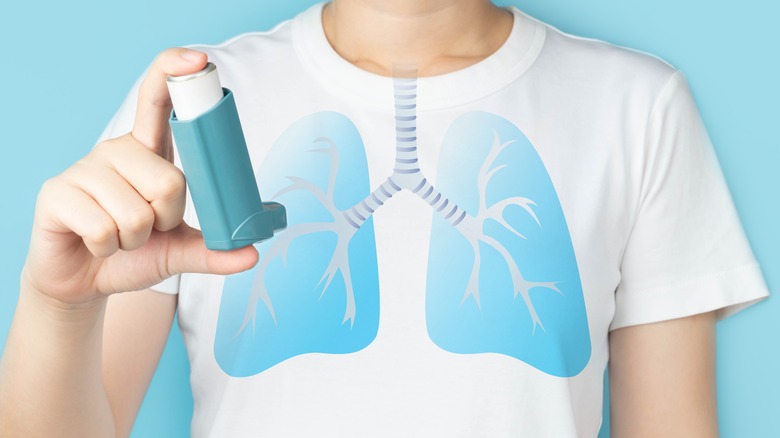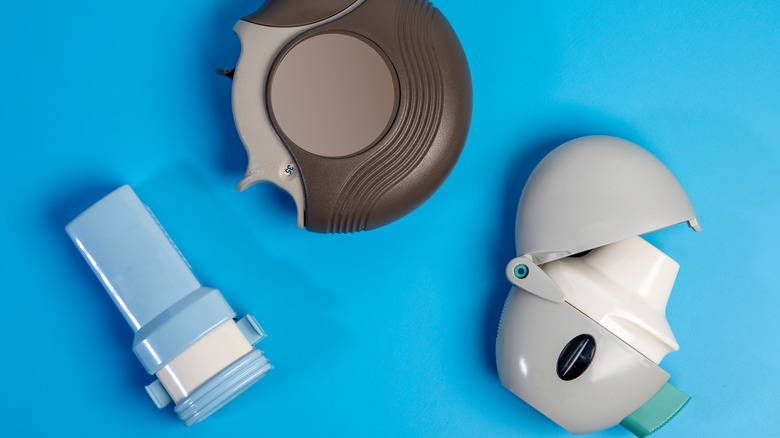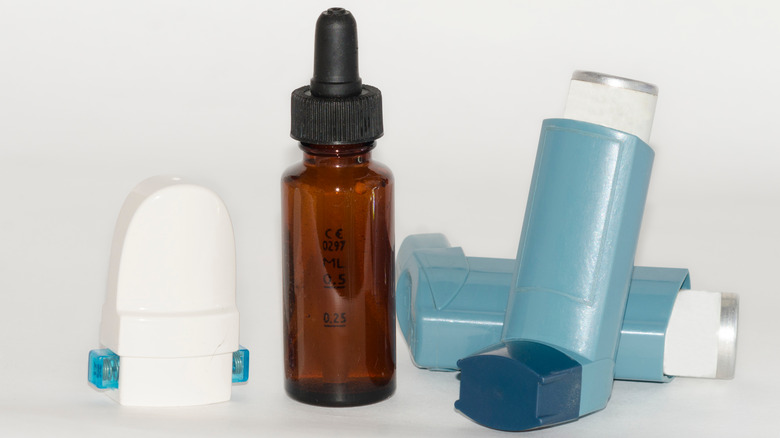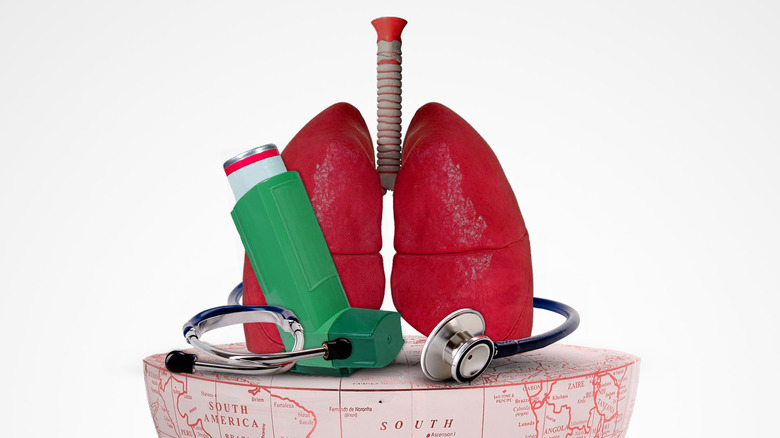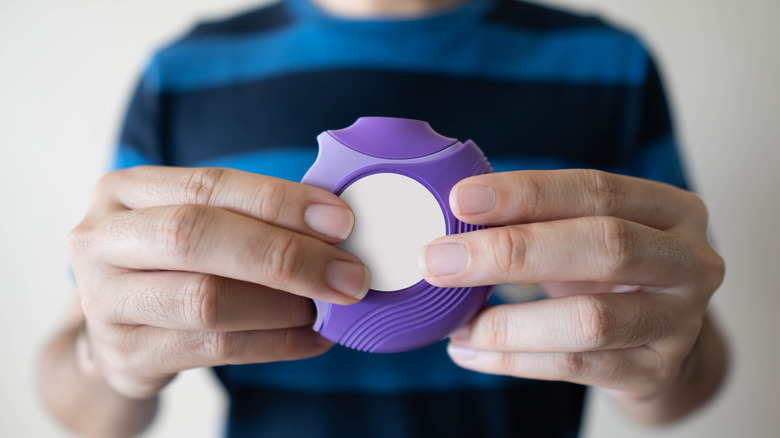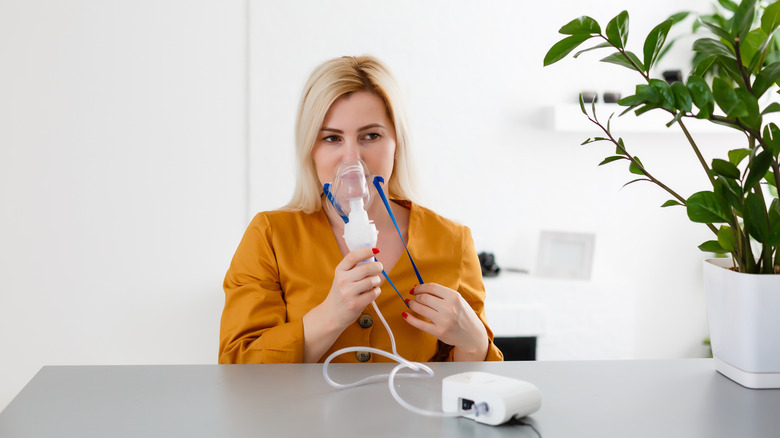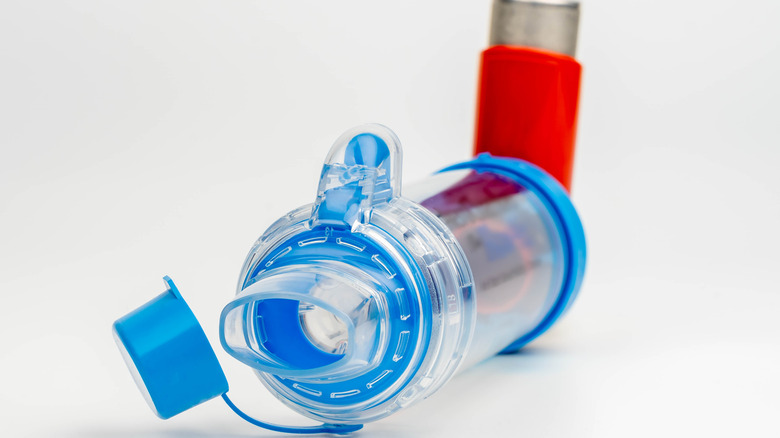Everything You Need To Know About Asthma Inhalers
When you breathe, air should easily move in and out of your lungs (via WebMD). However, the Centers for Disease Control and Prevention (CDC) reports that for over 25 million Americans, breathing can be difficult due to asthma. Asthma is a serious condition that affects the lungs (via National Heart, Lung, and Blood Institute). While everyone's lungs react to foreign substances, those with asthma have hypersensitive lungs. As a result, their body's immune system overreacts to certain air particles, causing the inner airway lining to swell.
Those with asthma may have to deal with increased size and stiffness of the muscles surrounding their lungs. Asthma can also cause the body to produce excess mucus, according to the Asthma and Allergy Foundation of America (AAFA). Together, the inflammation and mucus narrow the space available to breathe.
Asthma is chronic, so there is no cure. Therefore, patients must learn to manage symptoms and triggers. The best way to do so is by coming up with a plan with their doctor, including trigger avoidance and medications that help prevent attacks and relieve symptoms. One of the most common treatments used for asthma is medication delivered through an inhaler.
Symptoms of asthma
There are four main symptoms associated with asthma: a tight feeling chest, inability to catch one's breath, coughing, and a whistling sound when you exhale (via Mayo Clinic). This wheezing sound may not be audible to the human ear, but a physician will hear it using a stethoscope. Severity and frequency vary for everyone diagnosed. Asthma symptoms rarely last all day (via National Heart, Lung, and Blood Institute). Instead, they come and go with triggers and time of day. Asthma symptoms tend to be at their worst first thing in the morning and right before bedtime.
Common asthma triggers include colds, infections, and other medical issues, including allergies. In addition, winter's cold air and increasing breathing pace due to exercise, laughter, or crying can also cause asthma symptoms to act up.
Family history is a significant factor in determining whether or not you will develop asthma (via Cleveland Clinic). Other factors that increase your asthma risk include exposure to chemical irritants and secondhand smoke during early childhood.
Different types of asthma
Doctors diagnose your asthma type based on what triggers an attack. MedicalNewsToday lists seven kinds of this chronic disease: allergic and nonallergic, seasonal and occupational, exercise-induced, difficult to control, and severe.
As the name states, allergic asthma is brought on by environmental irritants such as pollen, pet dander, mold spores, dust mites, cockroaches, and cockroach feces. Tobacco, cars, and factories also contribute to allergic asthma, as do some perfumes and colognes. In addition, certain foods like milk, eggs, and nuts can also trigger an asthma attack. Nonallergic asthma is often brought on by environmental factors, including cold air, humidity, and stress. In addition, illnesses, infections, colds, and flu also contribute to nonallergic asthma.
Seasonal asthma flares at certain times of the year. Weather, air pollution, and pollen are the most significant contributing factors. Occupational asthma is also contingent on air pollution. Exposure to paint chemicals and other harmful aerosols, including insecticides, triggers attacks.
It's not uncommon to feel short of breath when you participate in strenuous activity, even if you exercise regularly. But those with exercise-induced asthma also experience coughing, wheezing, and chest pain when they physically exert themselves. Exercise-induced asthma isn't often diagnosed on its own, but rather generally accompanies other asthma diagnoses.
Difficult to control and severe asthma are harder to manage and happen more frequently. Those diagnosed with these two types of asthma are more likely to end up in the hospital from their attacks.
Doctors also label asthma based on when the diagnosis was made (via American College of Allergy, Asthma, & Immunology). It can be either pediatric or adult-onset asthma.
How do asthma inhalers work?
The most common way that doctors treat asthma is by prescribing the use of an inhaler to open your airway. This enables more oxygen to flow into your lungs (via Verywell Health). It's more potent to use an inhaler than to take the medication any other way (via Patient). This is because an inhaler enables the drugs to go straight to your lungs without passing through your bloodstream. The result is not only quicker, but also results in fewer side effects.
Depending on the severity of your asthma, your doctor will prescribe one of two types of inhalers: reliever or preventer. As the name indicates, reliever inhalers quickly diminish symptoms of sudden asthma attacks. It's best to use a reliever inhaler as soon as you feel out of breath. On the other hand, preventer inhalers work slower and last longer. Preventer inhalers help diminish the number of asthma attacks experienced, and are taken every day to stop the onset of symptoms. These inhalers are usually prescribed to those for whom reliever inhalers aren't providing sufficient relief of symptoms.
What are corticosteroids?
Your adrenal glands produce a hormone known as cortisol as a natural response to a crisis and stress (via Healthline). When your body releases cortisol, one of the things it does is change how your immune system responds to invaders. Inflammation often results from this process. Inflammation helps protect your body from invasion and sickness. Unfortunately, the immune system sometimes overreacts, and the resulting inflammation causes more harm than good. So scientists created a class of drugs called corticosteroids to help with inflammation (via Healthline). Doctors in various specialties prescribe corticosteroids in several forms, including an inhaled version for those with asthma.
When taken daily, corticosteroid inhalers like Flovent, Pulmicort, and Asmanex reduce inflammation and help prevent asthma attacks (via Mayo Clinic). For particularly bad flare-ups, doctors sometimes prescribe corticosteroids in tablet form (via Asthma & Lung UK). Though the pills are at a higher dosage than your inhaler, the prescription usually lasts for less than a week to keep side effects at a minimum.
What are bronchodilators?
While corticosteroids work to prevent asthma flare-ups, bronchodilators make breathing easier by helping to relax your lungs and keeping your airways open (via National Health Service). There are two types and three classes of bronchodilators (via Medical News Today). Your doctor may prescribe long- or short-acting bronchodilators with medication that falls into the class of Beta-2 agonists, Anticholinergic, or Xanthine derivatives.
As their names suggest, long-acting bronchodilators are taken daily and last up to 24 hours. These devices help prevent the onset of asthma attacks. Long-acting bronchodilators should never be taken without corticosteroids. On the other hand, short-acting bronchodilators are used as rescue inhalers. They work fast to relieve symptoms.
Inhalers that contain the medications known as Beta-2 agonists block your nerves from releasing the chemical that constricts your bronchial tubes. In doing so, the result of using these bronchodilators is a relaxed open airway. Xanthine bronchodilator inhalers also relax your airways, though experts are currently unsure by what mechanism they accomplish this. Additionally, due to the many known side effects, most medical practitioners try other medications before prescribing a Xanthine bronchodilator.
Metered-dose inhalers
In addition to the type of medication and how long it lasts, medical professionals prescribe asthma inhalers based on how they administer the drugs you need to prevent or stop an asthma attack. One of the most common is the metered-dose inhaler (MDI). The Cleveland Clinic describes a metered-dose inhaler as "a pressurized canister of medicine in a plastic holder with a mouthpiece." A pre-set amount of medication is released with each spray.
You should always prime your metered-dose inhaler to ensure it's ready for use and check the counter on the back to see how many sprays remain in the container. It's essential that you keep your MDI clean and remove any obstructions immediately.
Your physician may suggest you use a metered-dose inhaler with a spacer (also called a chamber), a hollow device that attaches to your MDI and is the part you would place in your mouth (via FamilyDoctor.org). A spacer can help filter your medication, thereby helping to prevent your throat from becoming irritated by it.
Dry powder inhalers
Another popular type of inhaler is the dry powder inhaler, or DPI. Like an MDI, DPIs dispense a set amount of medicine with each spray. However, the two devices distribute the medication a bit differently. When you use a DPI, your lungs release the powder medication from its seal. The capsule or disk is pierced when you inhale deeply and quickly (via GoodRx).
DPIs are usually used as preventer inhalers, and the main ingredient is a corticosteroid to reduce inflammation. However, some newer DPIs also help open airways with the use of a bronchodilator. Unlike MDIs, DPIs are not preloaded with medication. Instead, a capsule must be loaded into the device for each use. Additionally, as the name states, DPIs contain powder, while MDIs have liquid medicine. Another significant difference between DPIs and MDIs is how the drugs are released from the chamber. MDIs use a propellant to get the medicine from the inhaler to your lungs. On the other hand, DPIs use powdered lactose. Therefore, if you're lactose intolerant, DPIs may not be your best inhaler choice.
Breath-actuated inhalers
One of the most significant issues with inhalers is patient misuse. Indeed, according to the AAFA, about 9 in 10 users of inhalers don't use the device correctly. And unfortunately, improper usage results in less medication reaching the lungs. One way to combat this epidemic is through the use of breath-actuated inhalers (BAI).
While breath-actuated inhalers are similar to MDIs, they are easier to use. As a study published in Respiratory Medicine explains, BAIs contain a pressurized canister — but the medication is only released when the user inhales, meaning you don't need to worry about hand-mouth coordination and trying to breathe in at the same time the medication releases. Moreover, in a study of seniors published in the journal Chest, senior citizens not only preferred a BAI, but used it correctly more than 90% of the time.
Unlike traditional MDIs, a spacer is not needed with a BAI (via AAFA). Additionally, there's no need to shake or prime this type of inhaler before use. Your medical provider should remind you to only open the cover on your BAI when using the inhaler.
Soft mist inhalers
One of the newer asthma inhalers is the soft mist inhaler (SMI), according to the American Association for Respiratory Care. When used correctly, the medication contained in soft mist inhalers comes out more slowly than it does with other devices. Healthline states that the decreased release speed allows more medication to reach your lungs. Many traditional inhalers, even when used flawlessly, don't push the mist far enough, potentially leaving medicine in your throat and an aftertaste in your mouth.
As with the DPI, SMIs do not contain propellants, and a spacer is not needed for use. Therefore, there is no need to shake an SMI before use. Once you have correctly inserted the medical disk and primed your device, follow the general instructions from the Allergy and Asthma Network: "Exhale fully; put the inhaler mouthpiece into your mouth and close your lips around it; begin slow inhalation and press the dose release button. Continue to breathe in slowly and deeply. Remove the inhaler from your mouth, hold your breath for 10 seconds, then exhale."
Soft mist inhalers contain two bronchodilator drugs; tiotropium, sold under the brand name Spiriva Respimat, and olodaterol or Striverdi Respimat (via Healthline).
Nebulizers
A nebulizer is another device used to help a patient pull drugs directly into the lungs. However, while it serves a similar purpose to an inhaler, nebulizers have some key differences. Using either electricity or batteries, nebulizers transform liquid medication into a mist that is thin enough for you to inhale. Nebulizers require you to wear a face mask or mouthpiece (via Medical News Today).
Doctors prescribe one of three types of nebulizers: jet, ultrasonic, and mesh (via Healthline). The most prescribed type of nebulizer is the jet nebulizer. Jet nebulizers use air to turn the medication into an easily breathable mist. Ultrasonic nebulizers are common in hospitals and other medical settings. Ultrasonic nebulizers use vibrations to create an aerosol out of the medicine. Finally, mesh nebulizers are new to the market and deliver drugs through tiny holes.
In addition to bronchodilator drugs, nebulizers can help administer sterile saline solution and antibiotics. The saline helps to thin mucous and open airways, making it easier to cough up phlegm. Antibiotics delivered through a nebulizer are used for serious respiratory infections. Medical professionals generally prescribe nebulizer use to young children and others who might find it difficult to use an inhaler. On the downside, nebulizers require patients to sit still for up to 10 minutes while the medication is administered.
Asthma inhaler side effects
Regardless of what it is used to treat, every medication comes with side effects or unintended problems. The same holds true for the drugs dispensed through an asthma inhaler. Most side effects are mild and tolerable. However, do not stop taking your medication if the issues become worrisome. Instead, contacting a healthcare provider to discuss your options and get help is best.
As with any medicine, you run the risk of side effects when using inhaled corticosteroids. The most common include raspy voice, pain in the mouth and throat, and throat infections. Rinsing and gargling after use and/or using a spacer may help reduce the likelihood of these issues (via BetterHealth Channel). More severe and less common side effects associated with preventer inhalers and corticosteroids are long-term and include cataracts, glaucoma, and osteoporosis (via Verywell Health).
Reliever inhalers, or those containing bronchodilators, can have short-term side effects including headaches, nausea, and tachycardia or rapid heartbeat. These problems usually show up quickly after you take a puff from the inhaler and last a brief amount of time before disappearing (via MedicineNet).
Spacers
One of the best ways to ensure you use your asthma inhaler correctly and get the most medicine possible into your lungs is to use a spacer (via Philips). A spacer is a plastic tube. On one end of this football-shaped device is a mouthpiece or mask that covers your mouth and nose. On the other side is a place for you to insert your asthma inhaler. As the National Asthma Council Australia explains, spacers help to direct the drugs into your lungs. Not only does this mean that the medication is getting to the location where it needs to go, it also helps to prevent irritation and infections caused by medication getting trapped in the mouth and throat.
Spacers can also help those who have trouble coordinating their breathing with the inhaler, which is why they're often recommended for children (via National Asthma Council). Spacers are often used instead of nebulizers because they take less time and are easier to use, less expensive, and easier to transport. In addition, patients experienced fewer side effects using a spacer over a nebulizer. There are several different types of spacers, and your medical provider can help you choose the one that is best for you or your child.
Other asthma treatments
Inhalers are the most effective and common way to treat asthma and try and prevent flare-ups. However, there are other options available that your doctor may recommend. These include lifestyle changes and non-inhaled medication. First and foremost, the experts at Temple Health recommend that you learn what triggers your asthma so you can avoid those provocations as much as possible. You may also need to treat other medical conditions that worsen your asthma — for example, you might want to get allergy shots to diminish those triggers.
If your condition is particularly problematic or sudden, your medical provider may prescribe systemic corticosteroids (via Cleveland Clinic). Systemic corticosteroids are delivered through pills or injected liquids. However, it takes up to 12 hours to feel the effects. Oral doses can be given in high doses and then tapered off or in low doses daily. Another daily prescription for asthma is leukotriene modifiers. These drugs block the naturally occurring chemical that causes muscle tightness and regulates your body's mucous production. Finally, biologic injections of monoclonal antibodies can help block your body's response to asthma triggers and the resulting inflammation. Shots are given every 2 to 8 weeks.
When all else fails to improve your asthma, doctors perform bronchial thermoplasty. Done over three outpatient visits, an electrode to reduces the amount of smooth tissue that narrows your airways during an asthma attack. Once complete, you suffer from fewer asthma attacks and breathe much easier (via Temple Health).
What to do if you don't have your asthma inhaler?
Why does it seem that fate takes over and asthma attacks occur the one time you forget to carry your inhaler? Unfortunately, it may happen at one time or another. Knowing what to do will not only help you feel better, but it can also save your life. First and foremost, do not panic. Freaking out will only cause your symptoms to get worse. Instead, sit straight, loosen up your clothes, and take some deep, slow breaths. Healthline recommends trying one of four breathing techniques. Buteyko breathing involves breathing slowly through your nose. The Papworth method consists of using your diaphragm and nose. Diaphragmatic breathing involves focusing on your diaphragm as you breathe. Finally, yoga breathing techniques, or pranayama, require you to control the duration and timing of each breath. Another strategy is to drink a caffeinated beverage such as coffee or tea or breathe in over a pot of boiling water. If your symptoms don't improve in 15 minutes, or get worse, call 911 and seek medical attention.
Regardless of whether or not you have your inhaler, seek immediate medical attention if you are unable to have a conversation, are sweating profusely, or your breathing increases significantly in speed. Also, head to the emergency room if your skin color, particularly around your nails, turns blue or goes pale.

